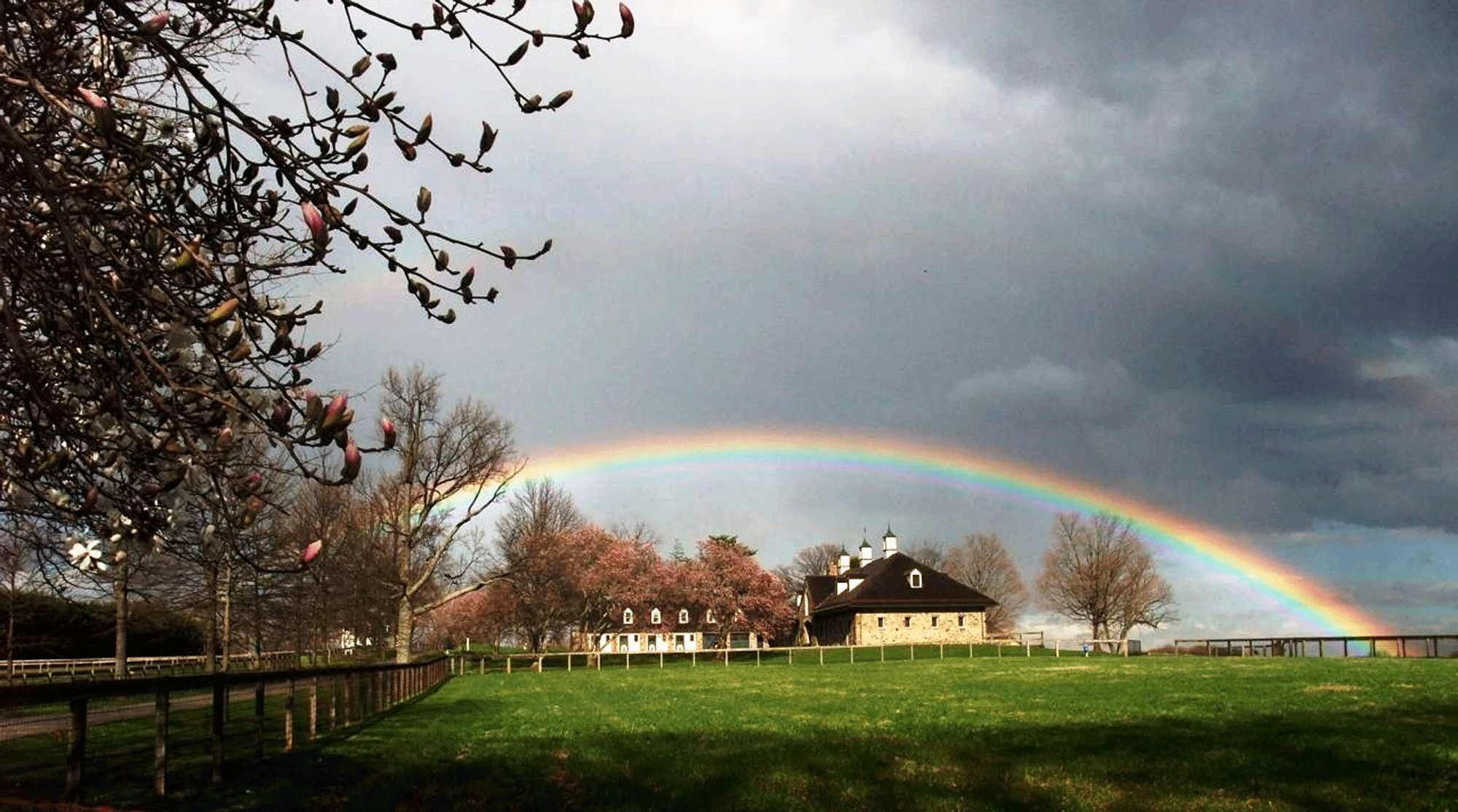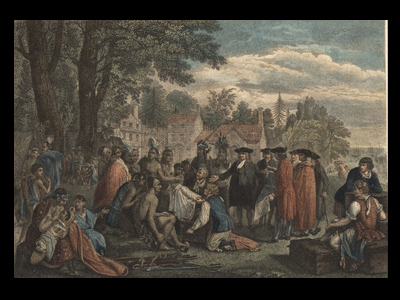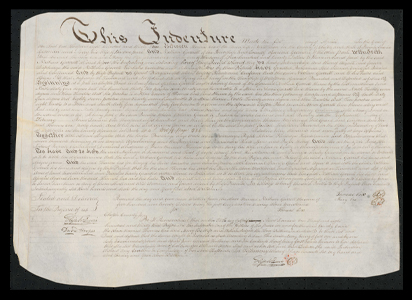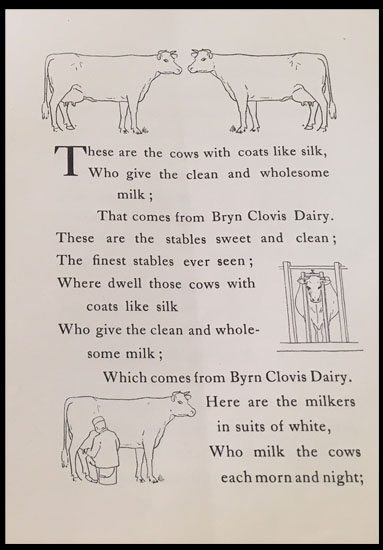The Story of Brushwood Stable and Bryn CLovis
 Modern-Day Brushwood and Bryn Clovis. Photograph courtesy of Brooks Adams.Learn more about Brushwood and Bryn Clovis by downloading the book here!
Modern-Day Brushwood and Bryn Clovis. Photograph courtesy of Brooks Adams.Learn more about Brushwood and Bryn Clovis by downloading the book here!Nestled within the open fields and the hills of eastern Chester County lies Brushwood Stable. Now home to world class race horses, the property's history spans back to the days of William Penn and the founding of Pennsylvania. Located near Willistown Township's Historic Sugartown, 20 miles west of Philadelphia, the property consists of two tracts of land divided by Sugartown Road: Brushwood lies to the southwest; and Bryn Clovis lies to the northeast. A unique collection of documents survive to tell their story, offering a great insight into not only the broader changes of a burgeoning country but also the unique stories pertaining to the Garrett, Sinquet, Baker, and Robert families.
 William Penn's Treaty with the Indians.The land, once belonging to the Okehoking Lenape, was slowly incorporated into Penn's Quaker colony and bore witness to a number of momentous historic events. From the arrival of William Penn in 1681 and the first European settlers through to the end of the French and Indian War (1754-1763), the property became a landscape of family farms. In 1684, English immigrants William Garrett and Samuel Lewis purchased the rights to a tract of land measuring 1000 acres from John Love, a First Purchaser. Neither man ever settled there. The Garrett portion of the tract, measuring 492 acres and later known as Bryn Clovis, was first settled in 1704 when William's (1) son Thomas and his wife Rebecca moved west. The Brushwood tract was first granted to Thomas Bowman and was re-granted in 1703 to Samuel Richardson. Brushwood was first settled by William (3) Garrett after buying the property. During the French and Indian War, the farm saw no fighting but the Garretts may have seen or interacted with settlers seeking refuge from more populated areas.
William Penn's Treaty with the Indians.The land, once belonging to the Okehoking Lenape, was slowly incorporated into Penn's Quaker colony and bore witness to a number of momentous historic events. From the arrival of William Penn in 1681 and the first European settlers through to the end of the French and Indian War (1754-1763), the property became a landscape of family farms. In 1684, English immigrants William Garrett and Samuel Lewis purchased the rights to a tract of land measuring 1000 acres from John Love, a First Purchaser. Neither man ever settled there. The Garrett portion of the tract, measuring 492 acres and later known as Bryn Clovis, was first settled in 1704 when William's (1) son Thomas and his wife Rebecca moved west. The Brushwood tract was first granted to Thomas Bowman and was re-granted in 1703 to Samuel Richardson. Brushwood was first settled by William (3) Garrett after buying the property. During the French and Indian War, the farm saw no fighting but the Garretts may have seen or interacted with settlers seeking refuge from more populated areas.
 Original Survey of the Garret Tract, 3 March 1685The defeat of the French kicked off a land rush. The colony saw a rise in population through the arrival of new settlers and the arrival of new generations. William (3) Garrett's lands were divided and sold to his children and Brushwood was sold to George Smedley. By the 1770s, Willistown increased its agricultural export economy and Chester County farmers like the Garretts and Smedleys sent one third to one half of their crops to Philadelphia to be exported to other colonies and beyond. During the American Revolution (1775-1783), Willistown found itself amidst the fighting with the Battle of Brandywine, the Battle of the Clouds, and the Paoli Massacre all being fought nearby. The Garretts and Smedleys seem to have escaped unscathed but many of their Willistown neighbors made claims for damages.
Original Survey of the Garret Tract, 3 March 1685The defeat of the French kicked off a land rush. The colony saw a rise in population through the arrival of new settlers and the arrival of new generations. William (3) Garrett's lands were divided and sold to his children and Brushwood was sold to George Smedley. By the 1770s, Willistown increased its agricultural export economy and Chester County farmers like the Garretts and Smedleys sent one third to one half of their crops to Philadelphia to be exported to other colonies and beyond. During the American Revolution (1775-1783), Willistown found itself amidst the fighting with the Battle of Brandywine, the Battle of the Clouds, and the Paoli Massacre all being fought nearby. The Garretts and Smedleys seem to have escaped unscathed but many of their Willistown neighbors made claims for damages.
Despite the troubles of the Revolutionary War, the Quaker community of Willistown was developing its own identity as an independent community. In 1784, the Goshen Monthly Meeting erected a schoolhouse in Willistown on three acres of Garrett land sold the previous year by William (3) and his son William (4). In the late 1780s, Willistown Friends successfully petitioned to create a local meeting and in 1793, William (4) Garrett Jr. obtained lands for a meetinghouse by acquiring land from Ann Smedley. Unlike Bryn Clovis, which stayed within the Garrett family, Brushwood changed hands several times. George Smedley's son Thomas sold the property to Amos Hoopes who then sold the farm to Daniel Sinquet and his wife Dorothy. The Sinquets subdivided the property and sold one small section to their son Daniel Jr. and a larger section to Joseph Freeman in 1804. The Freeman tract changed hands two more more times over the next thirty years.
 Nathan (2) Garrett Land Purchase, 1 April 1833During the early nineteenth century, these farms became increasingly commercial as they struggled to find a place in the country's rapidly changing economy. In the 1830s, Nathan (2) Garrett began expanding and improving Bryn Clovis by buying tracts of land and by adopting new technologies to increase crop and animal yields. In the 1840s, Nathan (2) established a commercial dairy at Bryn Clovis. Daniel Sinquet's son Samuel inherited the farm after the passing of his parents and who then sold the tract to William Baker of Edgemont. The Freeman Tract was sold to Esther Harris in 1840 who then sold a small portion to the Pennsylvania Railroad Company in 1851. By the middle of the nineteenth century, the cluster of farms around modern Bryn Clovis and Brushwood found new stability: Bryn Clovis remained with the Garrett family and Brushwood remained home to people with strong ancestral ties to the area. However, rapid changes and growing tensions, both locally and nationally, would soon see this relative stability threatened.
Nathan (2) Garrett Land Purchase, 1 April 1833During the early nineteenth century, these farms became increasingly commercial as they struggled to find a place in the country's rapidly changing economy. In the 1830s, Nathan (2) Garrett began expanding and improving Bryn Clovis by buying tracts of land and by adopting new technologies to increase crop and animal yields. In the 1840s, Nathan (2) established a commercial dairy at Bryn Clovis. Daniel Sinquet's son Samuel inherited the farm after the passing of his parents and who then sold the tract to William Baker of Edgemont. The Freeman Tract was sold to Esther Harris in 1840 who then sold a small portion to the Pennsylvania Railroad Company in 1851. By the middle of the nineteenth century, the cluster of farms around modern Bryn Clovis and Brushwood found new stability: Bryn Clovis remained with the Garrett family and Brushwood remained home to people with strong ancestral ties to the area. However, rapid changes and growing tensions, both locally and nationally, would soon see this relative stability threatened.
The second half of the nineteenth century was a tumultuous period of change for both Willistown and the nation as a whole. During the Civil War (1861-1865), over 20 Willistown men volunteered in the first few years of the war, and several more were caught up in the 1863 draft including Frederick Baker, eldest son of William, and Wilmer Garrett, Nathan's (2) eldest son. In April 1861, Willistown residents, including Nathan (2) Garrett, gathered at the Sugartown Hotel to plan local defense and pledge their support for the Union. In nearby Westtown, just a few miles from Brushwood and Bryn Clovis, a temporary POW camp was set up for Union soldiers taken by Confederate forces at Gettysburg. In the years after the war, fewer farms were passed down to sons and daughters, many of whom left to find better opportunities in cities and towns. Nathan Garrett (2) died in 1881 and William Baker died the following year. The Garrett farm passed to Nathan's (2) son Wilmer which then passed to Wilmer's siblings. After 200 years in the family, the Garrett farmstead was sold. The Baker's farm first passed to Levis Baker and then James Baker and by 1913, like Bryn Clovis, the farm passed out of the family's hands.
 Excerpt from the pamphlet A Lacteal Mother Goose; or, Milky Melodies for Modern Mothers (c. 1906). Used by kind permission of The College of Physicians of Philadelphia. Photograph by Beth Lander, Copyright 2018 by The College of Physicians of Philadelphia.As the children of farm families drifted away, their old lands were bought by wealthy families from Philadelphia and reborn as English-style country estates and summer homes. Like English estates, the farms were given names. Edward Lewis bought the old Garrett farmstead and named it Bryn Clovis. After Edward's death in 1901, the farm was taken over by his widowed daughter, Emily Lewis Roberts who enthusiastically took on the project of the farm, expanding the small collection of dairy cows purchased by her father and modernizing the establishment. Although not reflected in the deed collection, across the street from Bryn Clovis, the old Baker homestead was briefly occupied by Emily's son Sidney, who ran a goat dairy there. The name Brushwood may have been first applied under Sidney Roberts's tenure. Brushwood later became the home of John and Matilda Jackson and their son George. During this time, the plot, originally sold to Joseph Freeman, was reunited with the rest of the property.
Excerpt from the pamphlet A Lacteal Mother Goose; or, Milky Melodies for Modern Mothers (c. 1906). Used by kind permission of The College of Physicians of Philadelphia. Photograph by Beth Lander, Copyright 2018 by The College of Physicians of Philadelphia.As the children of farm families drifted away, their old lands were bought by wealthy families from Philadelphia and reborn as English-style country estates and summer homes. Like English estates, the farms were given names. Edward Lewis bought the old Garrett farmstead and named it Bryn Clovis. After Edward's death in 1901, the farm was taken over by his widowed daughter, Emily Lewis Roberts who enthusiastically took on the project of the farm, expanding the small collection of dairy cows purchased by her father and modernizing the establishment. Although not reflected in the deed collection, across the street from Bryn Clovis, the old Baker homestead was briefly occupied by Emily's son Sidney, who ran a goat dairy there. The name Brushwood may have been first applied under Sidney Roberts's tenure. Brushwood later became the home of John and Matilda Jackson and their son George. During this time, the plot, originally sold to Joseph Freeman, was reunited with the rest of the property.
The Brushwood and Bryn Clovis documents offer a rare insight into rural Pennsylvania from the late seventeenth through to the early twentieth century. From William Garrett, an English immigrant paving a new life in the William Penn's Quaker colony, to Emily Lewis Roberts's state of the art dairy, the deeds and documents, their lives have been preserved through the historical record.
Learn more about Brushwood and Bryn Clovis by downloading the book here!




